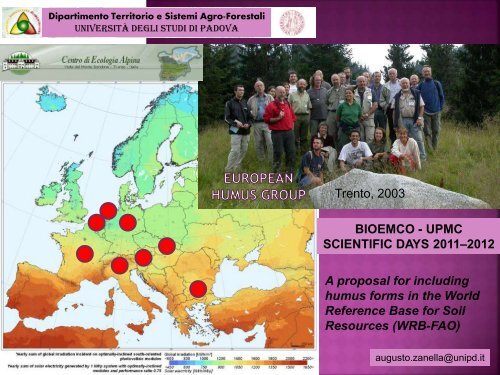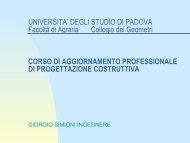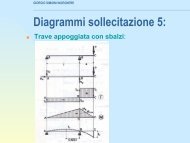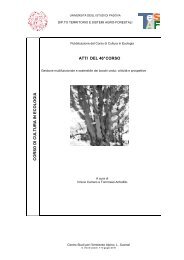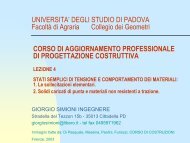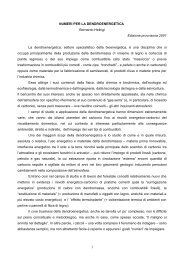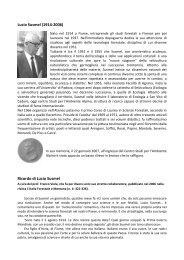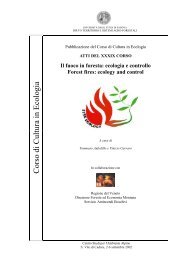humus group - Territorio e Sistemi agro-forestali - Università degli ...
humus group - Territorio e Sistemi agro-forestali - Università degli ...
humus group - Territorio e Sistemi agro-forestali - Università degli ...
You also want an ePaper? Increase the reach of your titles
YUMPU automatically turns print PDFs into web optimized ePapers that Google loves.
Dipartimento <strong>Territorio</strong> e <strong>Sistemi</strong> Agro-Forestali<br />
<strong>Università</strong> <strong>degli</strong> studi di Padova<br />
Trento, 2003<br />
BIOEMCO - UPMC<br />
SCIENTIFIC DAYS 2011–2012<br />
A proposal for including<br />
<strong>humus</strong> forms in the World<br />
Reference Base for Soil<br />
Resources (WRB-FAO)<br />
augusto.zanella@unipd.it
Trento<br />
2003<br />
Stato dell’arte<br />
origin of the<br />
Humus Group<br />
Freibourg<br />
Eurosoil 2004<br />
Vienna<br />
2004<br />
First common<br />
key (AMPHI)<br />
and paper<br />
HUMUS Group<br />
San Vito<br />
2005<br />
AMPHI<br />
HISTO<br />
TANGEL<br />
18° World Congress<br />
of Soil Science 2006<br />
Philadelphia<br />
2006<br />
Poster for the<br />
Congress<br />
Cagliari<br />
2007<br />
Mediterranean<br />
ecosystems<br />
(FAO vocabulary)<br />
HUMUS GROUP structure and functioning:<br />
- No pyramidal structure<br />
- No classic organisation, no chief or president, no...<br />
- When matter is ready for discussion, every member should organisea meeting with<br />
the whole HG, or with a <strong>group</strong> of interested people<br />
- If results, then diffusion:<br />
1. A European morpho-functional classification of <strong>humus</strong> forms. (GEODERMA, 2011)<br />
2. European Humus Forms Reference Base (2011).. http://hal.archivesouvertes.fr/docs/00/56/17/95/PDF/Humus_Forms_ERB_31_01_2011.pdf<br />
3. Humus Form ERB. A European Reference Base for <strong>humus</strong> forms: proposal for a morphofunctional<br />
classification (2010).. http://hal.archivesouvertes.fr/docs/00/54/14/96/PDF/Humus_Forms_ERB.pdf<br />
4. Terrestrial Humus Forms: Ecological Relevance and Classification. European. (Atlas of Soil<br />
Biodiversity 2010). .<br />
5. Towards a European <strong>humus</strong> forms reference base, (Studi trentinidi Scienze naturali, 2009)<br />
6. Towards a European classification of forest <strong>humus</strong> forms. Eurosoil - Freiburg. September<br />
4-12. Symposium 09 - Forest soil Monday 6th: 9.30-9.50 (2004). http;//www.bobenkunde.unifreiburg.de/eurosoil.<br />
Three not well defined Commissions (classification, vocabulary, diffusion)<br />
Eurosoil 2008<br />
Vienna<br />
Workshop:<br />
Leptoforms<br />
Rhizo, Ligno,<br />
Hydroforms<br />
Paris<br />
Trento<br />
2008 2009-2011<br />
Diffusion<br />
3 papers<br />
- European Geosciences Union<br />
General Assembly 2012<br />
- Bari (Italy): Eurosoil 2012
1. What’s a <strong>humus</strong> form (HF) ?<br />
a. A European key of classification of HF, why ?<br />
b. Field reality, mind concepts<br />
2. Process of classification of HF<br />
a. Soil profile and diagnostic horizons<br />
b. Are there special series of horizons, series more important than others ?<br />
Why ?<br />
c. How can we circumscribe these particular series ?<br />
3. A European Humus <strong>group</strong> and step by step solution:<br />
1. Trento, Vienna: diagnostic horizons, main terrestrial HF…<br />
2. San Vito: Histoforms, Tangel, vocabulary, diffusion, biological overview, ….<br />
3. Cagliari: Mediterranean systems, Amphi, A structure, FAOwrb concepts, …<br />
4. Vienna, Paris: general tree, rhizo, ligno, hydro, enti….<br />
5. Attempt to include the European <strong>humus</strong> forms classification in<br />
the World Reference Base for Soil Resources (WRB-FAO)
Main diagnostic horizons of a SOIL PROFILE<br />
Semiterrestrial<br />
(with water)<br />
OLg<br />
OFg<br />
OHg<br />
Hf<br />
Hm<br />
Hs<br />
Hsl<br />
Aa, Ag<br />
Sg, Bg, g, G<br />
Cg, Mg, Dg<br />
R<br />
OL<br />
OF<br />
OH<br />
A organo-mineral<br />
B, E, S<br />
C, M, D<br />
R<br />
Terrestrial<br />
(with air)<br />
mineral<br />
Humus form<br />
Soil profile
HUMUS FORM<br />
OL<br />
OF<br />
OH<br />
A<br />
B<br />
HUMUS FORM<br />
Organic and<br />
organomineral<br />
part<br />
of soil<br />
Dark part<br />
of soil
Plant<br />
cover<br />
Living<br />
soil<br />
Mineral<br />
material<br />
Climate<br />
Litter<br />
Recognizable remains<br />
Inherited or newly<br />
formed mineral particles<br />
Rock fragments<br />
TIME<br />
Humic component<br />
Mineral component<br />
Figure 1. Vocabulary and dynamic formation of a sample of topsoil.<br />
FUNGAL (non faunal) dominant process<br />
Non zoogenically transformed material<br />
OR<br />
ANIMAL (faunal) dominant process<br />
Zoogenically transformed material<br />
OL<br />
OF<br />
OH<br />
A<br />
Organic and<br />
organo-mineral<br />
HORIZONS
HORIZONS
AMPHI<br />
AC<br />
A1<br />
C<br />
OF<br />
A2<br />
OH
Sfogliatura di orizzonti<br />
Unveiling diagnostic horizons<br />
OLn OLv OF A
OL<br />
OF<br />
OH<br />
Sal<br />
Ami<br />
Gradual transition
OH<br />
E<br />
MOR
10<br />
90<br />
Figure 2<br />
70%<br />
30 %<br />
OL OF OH<br />
% volume roots excluded<br />
OL – OF - OH<br />
30<br />
70<br />
HUMIC COMPONENTS (HC) = Small particles<br />
of organic remains and/or grains of organic or<br />
organo-mineral matter mostly comprised of<br />
animal droppings of different sizes. The<br />
original organs which compose the litter and<br />
generate the small particles (free or<br />
incorporated in animal faeces) are not<br />
recognizable by the naked eye or with a 5-10 X<br />
magnifying hand lens. Bound mineral particles<br />
can be visible within the mass. Well<br />
decomposed organic substrate is generally<br />
100% humic component. However, the<br />
generated humic component can also be in the<br />
hemorganic (A) and organic (OL, OF, OH)<br />
horizons.<br />
RECOGNIZABLE REMAINS (RR) = Organic<br />
remains like leaves, needles, roots, bark, twigs<br />
and wood, fragmented or not, whose original<br />
organs are recognizable by the naked eye or<br />
with a 5-10 X magnifying hand lens. Fresh litter<br />
is generally 100% recognizable remains.
Earthworms<br />
like that<br />
San Vito, 2005<br />
Ils sont fous<br />
ces<br />
Romains
OL<br />
A<br />
BIOMACROSTRUCTURE<br />
MULL
1<br />
cm<br />
BIOMESOSTRUCTURE
1<br />
cm<br />
BIOMICROSTRUCTURE
sample<br />
box<br />
rubber ring<br />
spring<br />
1) sample in the box<br />
(Ø 2 - 3,5 cm)<br />
2) let fall the box 5 times<br />
1 jump = 100g/1,5 m<br />
(sample + box) system<br />
1 cm3<br />
(1,5 Kg)<br />
2 Kg
STRUCTURE = a SCALE problem<br />
Our approach concerns the space having dimensions from 1/10 of mm to 1-2 cm<br />
R. Secco<br />
h = 2m<br />
1) sample in the ball (Ø 3 cm)<br />
2) Let fall the ball 3 times<br />
Force against the sample = 1N (= a weight of<br />
100g on the sample)<br />
Observation of the sample:<br />
magnitude from 10X to 50X
1 cm<br />
1 cm<br />
1 mm<br />
1 mm<br />
micro<br />
meso
4<br />
4<br />
5<br />
6<br />
Diplopods<br />
1 cm<br />
Epigeic<br />
1 3<br />
2<br />
earthworms<br />
2<br />
Encytraeids<br />
3 6<br />
Insect larves 4<br />
2<br />
8<br />
7<br />
4<br />
7<br />
8<br />
Acarians<br />
Chilopods<br />
Isopods<br />
Spiders<br />
1<br />
3<br />
5<br />
6<br />
7<br />
8
MICRO<br />
Enchytreids, Epigeic<br />
earthworms and<br />
Microarthropods<br />
0.5<br />
Ø 1 mm<br />
MACRO<br />
Anecic and<br />
Endogeic<br />
earthworms<br />
2<br />
Ø >1-3 mm<br />
MESO<br />
Endogeic and Epigeic earthworms,<br />
Arthropods and Enchytreids<br />
3<br />
5<br />
Ø >1- 4 mm<br />
Ø 4 mm<br />
Ø >= 4 mm<br />
Ø
Humic component on a palm hand.<br />
This scrap of OH horizon is mostly<br />
composed of minute animal<br />
(arthropod and enchytraeid)<br />
droppings. It also corresponds to a<br />
sample of zoogenically transformed<br />
material.<br />
Non-zoogenically transformed material.<br />
Dry or cold climate, acidity,<br />
unpalatibility of the substrate,<br />
introduction of new and unadapted<br />
species (here the case of an organic<br />
topsoil in an artificial stand of Pinus<br />
radiata in substitution of a natural<br />
Quercus ilex forest) lags behind the<br />
arrival of pedofauna. The<br />
decomposition of the organic substrate<br />
is essentially due to fungal attack.
Lophodermium piceae<br />
Marasmius androsaceus Thysanophora penicilloides<br />
?<br />
Mushrooms in a MOR on spruce needles
OF<br />
Figure 3<br />
zo<br />
% volume<br />
roots excluded<br />
90<br />
10<br />
noz<br />
OFzo : zoogenic transformed material ><br />
10 % of the volume of the horizon after<br />
removing living roots.<br />
OFnoz : non zoogenic transformed<br />
material >= 90 % of the volume of the<br />
horizon after removing living roots.<br />
ZOOGENIC TRANSFORMED MATERIAL = RECOGNIZABLE<br />
REMAINS AND HUMIC COMPONENTS processed by animals<br />
= leaves, needles and other plant residues more or less degraded<br />
by soil animals, mixed with animal droppings. A fine powdered<br />
and/or grained structure (less than 1 mm) is typical in a terminal<br />
stage of faunal attack in an organic horizon. At this last level of<br />
biotransformation, the substrate (OH horizon) is essentially<br />
comprised of organic animal droppings of varying size (droppings<br />
of epigeic earthworms, macroarthropods such as millipedes,<br />
woodlice and insect larvae, microarthropods such as mites and<br />
springtails and enchytraeids dominate). Within hemorganic<br />
horizons, animal activity leads to different types of A horizons,<br />
depending on the animals’ ability to dig into the mineral soil and<br />
thoroughly mix organic and mineral matter.<br />
NON ZOOGENIC TRANSFORMED MATERIAL = REMAINS AND<br />
HUMIC COMPONENT processed by fungi or other non-faunal<br />
processes = leaves, needles and other plant residues more or<br />
less fragmented and transformed into fibrous matter by fungi.<br />
Recognizable and recent animal droppings are absent or not<br />
detectable by the naked eye in the organic horizons; fungal<br />
hyphae can be recognized as white, brown or yellow strands<br />
permeating the organic or hemorganic substrates; traces of animal<br />
activity (old bite marks, mucus) may sometimes be detectable but<br />
are always marginal. In the last stage of biodegradation of an<br />
organic horizon, non zoogenic substance may essentially be<br />
composed of brown, dry plant residues more or less in powder<br />
form or tiny fragments (OF and OH horizons), or be massive like a<br />
dark wet plastic clay (OH or very organic A horizons).
Amphi<br />
WANTED<br />
dead or alive<br />
Alpenmoder or Tangel ? What’s a Tangel ?<br />
Wien, 2004<br />
Mor-Moder with large earthworms,<br />
is-it possible ? Yes it is. Why ?
TANGEL AMPHI MULL MODER MOR<br />
horizon pedofauna tr eu tr eu eu tr eu tr tr<br />
eu<br />
OL<br />
OFzo<br />
OH<br />
OFnoz<br />
miA<br />
meA<br />
maA<br />
Anoz<br />
Epigeic earthworms<br />
and/or Arthropods<br />
and/or Enchytraeids<br />
Non zoogenic<br />
Epigeic earthworms<br />
and/or Arthropods<br />
and/or Enchytraeids<br />
Epigeic (epi-endogeic, epianecic)<br />
Endogeic (polyhumic,<br />
mesohumic, endo-anecic,<br />
oligohumic)<br />
Endogeic (endo-anecic,<br />
oligohumic)<br />
Anecic earthworms<br />
Non zoogenic<br />
Asg or Ams
SERIES
optimal<br />
conditions<br />
MULL<br />
HUMUS DA LOMBRICHI<br />
Suoli bruni<br />
Clima, Substrato, Vegetazione Pedoclima<br />
MU lomb<br />
MU erde<br />
sfavorevoli<br />
favorevoli<br />
MOG artro<br />
MOF artro<br />
(+ artro)<br />
from SUSMEL L. (1962) lessons<br />
according to HARTMANN F.<br />
(evolution of an Italian/Austrian model)<br />
MO artro mic<br />
MU lomb<br />
melanizz<br />
HUMUS ZOOGENICO GEMELLARE ?<br />
Suoli calcarei e umocalcarei<br />
MODER<br />
HUMUS ZOOGENICO GEMELLARE ?<br />
Suoli desaturati<br />
caldo, siccità estiva;<br />
roccia carbonatica<br />
hot,<br />
dry,<br />
calcareous<br />
uneasy<br />
conditions<br />
FUNGI<br />
uneasy<br />
conditions<br />
fresco<br />
secco<br />
MOF artro MOF artro<br />
MU artro MU artro<br />
MU lomb<br />
freddo, breve stagione<br />
vegetativa; degrado;<br />
roccia acida<br />
cold,<br />
rainy,<br />
acid<br />
MO mic<br />
To S mic<br />
MOG artro<br />
MOF artro<br />
MOR<br />
HUMUS MICOGENICO<br />
TORBA SECCA FORESTALE<br />
Suoli acidi e Podzol<br />
da LOMBRICHI da LOMBRICHI (CaCO3) da ARTROPODI da ARTROPODI e MICETI ERDE TORBOSA<br />
E To<br />
cold, dry<br />
DYSMODER ?<br />
HUMUS DA ARTROPODI<br />
Suoli acidi<br />
MU = Mull = dejections, the whole horizon<br />
MOG = Moder Grossolano = droppings< 50% vol.<br />
MOF = Moder Fine = droppings >50% vol.<br />
To = Torba = Peat; lomb = lombric; artro = arthropods;<br />
mic = mycogenic
Hypothetical<br />
evolutionary lines and<br />
“WELLS” in a model of<br />
four <strong>humus</strong> forms<br />
2 - UNFAVOURABLE CONDITIONS for<br />
ANECIC WORMS but important<br />
MESOFAUNA like Arthropods and<br />
Enchytreids<br />
Ex. Input: Filtering sandy rocks,<br />
raining climate, mixed forest,<br />
broadleafed and coniferous<br />
Output: (Eluviation), Acidification,<br />
LUVISOL, Dystric CAMBISOL<br />
3 - VERY<br />
UNFAVOURABLE<br />
CONDITIONS for animal<br />
activity<br />
Ex. Input: Acid substrate<br />
Cold climate,<br />
Coniferous forest<br />
Output: Podzolisation,<br />
Haplic PODZOL, Umbric<br />
LEPTOSOL<br />
MOR<br />
MODER<br />
MULL<br />
1 - NO CLIMATIC and<br />
NUTRITIONAL<br />
CONSTRAINTS for<br />
biological activity<br />
Ex. Input: Neutral rock<br />
Temperate climate<br />
Broad-leaved forest<br />
Output: Brunification<br />
CAMBISOL<br />
Freiburg, 2004<br />
4 -PERIODIC<br />
UNFAVOURABLE<br />
AMPHI<br />
CLIMATIC<br />
CONDITIONS on<br />
Calcareous<br />
substrate<br />
Ex. Input : Mediterranean climate and<br />
vegetation, low mountain ranges<br />
Output: Calcification, Melanisation<br />
Rendzic LEPTOSOL, PHAEOZEM
Tangel<strong>humus</strong> in the Alps / Baier, R., E. Kolb<br />
How to place Tangel in the scheme of<br />
<strong>humus</strong> forms?<br />
• Tangel is characterized by shallow/lacking Ah horizons.<br />
• Tangel is dominated by arthropodes. Lumbricides participation is of<br />
minor importance.<br />
In an Amphi arthropodes (Oh) and Lumbricides (Ah) are important.<br />
From: Katzensteiner, K., H. Hager, M. Englisch, 2005.<br />
Main <strong>humus</strong> forms: stages of<br />
high probability in the continuum<br />
of organic matter decay.<br />
Conclusion: Tangel is no Amphi due to lacking „twin“ characteristics.
Possible definition for Tangel?<br />
• Tangel is a zoogenous (arthropods are dominant) <strong>humus</strong> form<br />
overlaying coarse debris or solid bedrocks.<br />
• An underlaying mineral horizon is shallow or lacking.<br />
• The parent material is slowly decomposing (litter originating from<br />
mountain pine, spruce and even beech – always mountainous belt).<br />
Definition<br />
A<br />
OH
Con la FAO si<br />
va meglio<br />
E dove<br />
andiamo ?<br />
Cagliari, 2007
pH A<br />
H 2O<br />
GRAVITY<br />
CENTERS<br />
9<br />
8<br />
7<br />
6<br />
4<br />
3<br />
5<br />
MOR<br />
TANGEL<br />
-5 0 10 15<br />
AMPHI<br />
20<br />
MODER<br />
Annual temperature (°C)<br />
25<br />
30<br />
MULL<br />
100<br />
0<br />
2500<br />
2000<br />
1500 Annual<br />
1000 rainfall (mm)
Cold<br />
calcareous<br />
deviation<br />
TANGEL<br />
dys<br />
eu<br />
Periodical dryness<br />
Calcic melanisation<br />
AMPHI<br />
eumeso<br />
pachy<br />
lepto<br />
eumacro<br />
Temperate<br />
neutral<br />
attractor<br />
MULL<br />
eu<br />
meso<br />
oligo dys<br />
Eluviation<br />
Podzolisation<br />
MODER<br />
eu<br />
hemi<br />
dys<br />
MOR<br />
hemi<br />
humi<br />
arthropods enchytraeids arthropods, enchytraeids<br />
epigeic earthworms epigeic earthw..<br />
endogeic earthworms<br />
anecic earthworms<br />
eu<br />
fungi<br />
Cold<br />
acid<br />
deviation
HORIZON<br />
On<br />
OLv<br />
OF<br />
noz<br />
OF<br />
zo<br />
TANGEL AMPHI MULL MODER MOR<br />
dys eu pachy<br />
OH OH > 2xA<br />
Trans<br />
< 5<br />
mm<br />
≥ 3<br />
cm<br />
eu<br />
meso<br />
< 3<br />
cm<br />
eu<br />
macro<br />
≥ 1<br />
cm<br />
lepto oligo eu meso dys hemi eu dys hemi humi eu<br />
< 1<br />
cm<br />
disc<br />
pock<br />
disc<br />
pock<br />
disc<br />
pock<br />
≥ 5 mm < 5 mm < 3 mm ≥ 5 mm < 3 mm Trans<br />
Anoz msA sgA, msA<br />
miA<br />
meA or<br />
mi A and/or<br />
meA<br />
or only meA<br />
A ≥ OH/2<br />
disc<br />
pock<br />
≤ 1<br />
cm<br />
> 1<br />
cm<br />
disc<br />
pock<br />
disc<br />
pock<br />
disc<br />
pock<br />
A absent = E<br />
or sgA, or msA,<br />
HORIZON<br />
OLn<br />
OLv<br />
OF<br />
noz<br />
OF<br />
zo<br />
OH<br />
zo<br />
Anoz<br />
or or possible miA<br />
or or meA<br />
maA A ≥ OH/2 maA<br />
pH A<br />
H 2O<br />
≥ 5 < 5<br />
23/04/2010<br />
pH A<br />
H 2O
A<br />
OF<br />
B<br />
OH<br />
OL<br />
OFg<br />
OHg<br />
Aa<br />
OLg
Hf<br />
Hfs<br />
Hszo<br />
Hsnoz<br />
Hsl<br />
Aa<br />
Ag<br />
HISTO<br />
MOR<br />
HISTO<br />
MODER<br />
HISTO<br />
AMPHI<br />
ANMOOR<br />
fibri humi fibri humi mesi sapri fibri humi mesi sapri limi<br />
limi sapri eu<br />
I<br />
II<br />
II<br />
I<br />
III<br />
III<br />
I<br />
II<br />
I<br />
II<br />
II<br />
I<br />
II II<br />
III<br />
II<br />
I I I<br />
I>II>III = hierarchical order of thickness<br />
( ) = possible<br />
HISTO<br />
MULL<br />
I<br />
(II)<br />
I<br />
(II)<br />
(II)<br />
II<br />
I<br />
(II)<br />
II<br />
I
RHIZO<br />
Mor<br />
Epi<br />
Terro<br />
Moder<br />
Tangel<br />
Amphi<br />
Amphi<br />
Mull<br />
Mull<br />
Moder<br />
Mor<br />
ENTI<br />
Hydro<br />
Anmoor<br />
Histo<br />
LIGNO
New starting point, 2005
TERRO<br />
ENTI<br />
Litho<br />
Peyro<br />
Psammo<br />
PARA<br />
Rhizo<br />
Ligno<br />
HISTO<br />
HYDRO<br />
Anmoor<br />
Amphi<br />
Mull<br />
Moder<br />
Mor<br />
Eu<br />
Sapri<br />
Limi<br />
Limi<br />
Sapri<br />
Humi<br />
Mesi<br />
Fibri<br />
Sapri<br />
Humi<br />
Mesi<br />
Fibri<br />
Mesi<br />
Fibri<br />
Tangel<br />
Mor<br />
Moder<br />
Mull<br />
Amphi<br />
EPIHISTO<br />
Anmoor<br />
Mor<br />
Moder<br />
Mull<br />
Amphi<br />
Litho- or<br />
Peyro- or<br />
Psammo-<br />
Tangel<br />
Mor<br />
Moder<br />
Mull<br />
Amphi<br />
Rhizo- or<br />
Ligno-<br />
Tangel<br />
Mor<br />
Moder<br />
Mull<br />
Amphi<br />
Dys<br />
Eu<br />
Pachy<br />
Eumeso<br />
Eumacro<br />
Lepto<br />
Oligo<br />
Eu<br />
Meso<br />
Dys<br />
Hemi<br />
Eu<br />
Dys<br />
Hemi<br />
Humi<br />
Eu<br />
Tangel<br />
Amphi<br />
Mull<br />
Moder<br />
Mor<br />
Epihisto-<br />
(Histo-)<br />
(Terro-)<br />
Hydro-
32WRB - Soil REFERENCES – 34 RP
FAO WRB<br />
Ex.: Albic LUVISOL (Arenic)
Prefix qualifiers:<br />
haplic, lithic, peyric, psammic, rhizic, lignic, bryoic<br />
hydric, epihistic, anrthric<br />
stagnic, gleyic,<br />
Ex.:<br />
Lithic, rhizic<br />
(Suffix qualifiers):<br />
EUMODER (humic, umbric)<br />
andic, alcalic, clayic, eutric, hypereutric, humic, hyperhumic ,<br />
mollic, umbric, pachic….<br />
ENTIHUMUS<br />
PARAHUMUS<br />
DYSTANGEL<br />
EUTANGEL<br />
PACHYAMPHI<br />
EUMESOAMPHI<br />
EUMACROAMPHI<br />
LEPTOAMPHI<br />
OLIGOMULL<br />
EUMULL<br />
MESOMULL<br />
DYSMULL<br />
HEMIMODER<br />
EUMODER<br />
DYSMODER<br />
HEMIMOR<br />
HUMIMOR<br />
EUMOR<br />
EUANMOOR<br />
SAPRIANMOOR<br />
LIMIANMOOR<br />
LIMIMULL<br />
SAPRIMULL<br />
HUMIAMPHI<br />
MESIAMPHI<br />
FIBRIAMPHI<br />
SAPRIMODER<br />
HUMIMODER<br />
MESIMODRE<br />
FIBRIMODER<br />
MESIMOR<br />
FIBRIMOR<br />
1 +<br />
2 +<br />
16 +<br />
14<br />
Absence of diagnostic horizons or total thickness<br />
of diagnostic horizons (OH + OF + A) < 2 cm<br />
Humus profile with lignic, rhizic or bryoic material<br />
over more than 2/3 of thickness<br />
= 32 HUMUS REFERENCES
• The classification will be updated every 2 years.<br />
• Interested people are invited to collaborate and/or to test the<br />
classification system in various field areas.<br />
• The 10 basic references for <strong>humus</strong> forms are the result of a<br />
corresponding number of processes of soil organic matter<br />
biodegradation: 5 terrestrial (Tangel, Amphi, Mull, Moder e Mor)<br />
and 5 semiterrestrial (Anmoor, Mull, Amphi, Moder and Mor)<br />
forms.<br />
• Presently the Humus <strong>group</strong> is assessing environmental<br />
(vegetation, soil, biome), biological (fungi, bacteria, pedofauna),<br />
physical (air temperature, rainfall) and chemical (pH, mineral<br />
elements, quality and quantity of humic molecules…) factors<br />
which characterize basic <strong>humus</strong> forms and their varieties.<br />
• Every contribution to this topic is welcome<br />
(contact: augusto.zanella@unipd.it).
On behalf of the HUMUS GROUP,<br />
60 participants, 12 country:<br />
Adriano Garlato (Italy), Andrea Squartini (Italy), Alain Brethes (France), Andrea Vacca (Italy),<br />
Augusto Zanella (Italy), Anna Andreatta (Italy), Bas Van Delft (The Netherlands), Bernard Jabiol<br />
(France), Diego Pizzeghello (Italy), Eckart Kolb (Germany), Elena Vendramin (Italy), Emil Klimo<br />
(Czech Republic), Erik Karltun (Sweden), Erwin Mayer (Austria), Eva Ritter (Finland), Fabrice<br />
Bureau (France), Fausto Fontanella (Italy), Gabriele Broll (Germany), Gerhard Milbert (Germany),<br />
Giacomo Sartori (Italy), Gianluca Serra (Italy), Giuseppe Concheri (Italy), Hannu Jlvesniemi<br />
(Finland), Hans-Joerg Brauckmann (Germany), Herbert Hager (Austria), Jan Sevink (The<br />
Netherlands), Jean-François Ponge (France), Jarmila Lesna (Czech republic), Jean Jacques Brun<br />
(France), Klaus Katzensteiner (Austria), Lars Lundin (Sweden), Lauric Cécillon (France), Linda<br />
Scattolin (Italy), Lorenzo Frizzera (Italy), Lucio Montecchio (Italy), Marija Grozeva Sokolovska<br />
(Bulgaria), Michael Aubert (France), Michael English (Austria), Miglena Zhiyanki (Bulgaria), Mirco<br />
Rodeghiero (Italy), Nathalie Cassagna (France), Nathalie Cools (Belgium), Paola Galvan (Italy),<br />
Paolo Carletti (Italy), Raimo Kolli (Estonia), Rainer Baritz (Germany), Rein de Waal (The<br />
Netherlands), Roberto Menardi (Italy), Roberto Secco (Italy), Roberto Zampedri (Italy), Roger<br />
Langohr (Belgium), Roland Baier (Germany), Rolf Kemmers (The Netherland), Serenella Nardi<br />
(Italy), Silvia Chersich (Italy), Silvia Obber (Italy), Tomaz Kralj (Slovenia), Ugo Wolf (Italy), Ulfert<br />
Graefe (Germany).


